- What is Common Cold
- Statistics on Common Cold
- Risk Factors for Common Cold
- Progression of Common Cold
- Symptoms of Common Cold
- Clinical Examination of Common Cold
- How is Common Cold Diagnosed?
- Prognosis of Common Cold
- How is Common Cold Treated?
- Common Cold References
What is Common Cold
| The common cold is an acute infection of the throat and nasal passages. It may be caused by several different viruses, the most common of which are rhinoviruses. The term ‘common cold’ refers to a set of symptoms, rather than a specific disease.Mild influenza may have similar symptoms to the common cold. Mild ‘strep throat’, which is caused by bacteria, may be incorrectly classified as a common cold, though usually it is easy for a doctor to distinguish between the two. |
Common cold viruses may be spread by:
- Contact transmission: People infected with the virus touch their mouth, nose or eyes (mucous membranes), or cough or sneeze into their hands, before touching someone else (direct contact transmission) or touching a common surface (indirect contact transmission). Cold viruses may remain alive on the skin for two hours, and on other surfaces (such as bench tops) for several hours;
- Droplet transmission: Small particles of the virus are coughed or sneezed into the air, where it lingers before spreading to others; and
- Large particles of the virus are coughed or sneezed into the air, and directly spread to the mucous membranes of others.
The spread of the cold from person to person is dependent on the amount of time people spend together, and the amount of virus the infected person is producing. Porous materials (e.g. tissues, handkerchiefs) are not an efficient way for the virus to spread, and do not support virus survival. Saliva is not efficient in spreading most cold viruses; 90% of individuals with colds having no detectable virus in their saliva.
Although commonly accepted to be true, cold weather does not appear to increase the risk of contracting a cold. The increased occurrence of colds in cold weather is actually due to factors associated with winter such as the increased amount of time people spend indoors with other potentially infected people. Also, environmental changes such as reduced humidity associated with indoor heating provides ideal growth conditions for the viruses that cause the common cold and also dries out the mucous membranes of the nose which naturally protect against infection.
Statistics on Common Cold
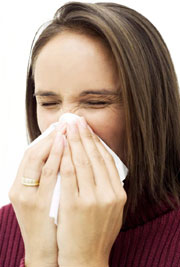
The number of the colds increases rapidly throughout the autumn months, remains high during winter, and decreases during spring. Colds occur more commonly during the rainy season in tropical areas.
In the US, the common cold results in 20 million days of absence from work and 22 million days of absence from school each year.Worldwide, 25 million people visit the GP with uncomplicated upper respiratory tract infections each year.
Risk Factors for Common Cold
The following factors may increase a person’s risk of catching a cold:
- Age: The younger you are, the more likely you are to develop a cold.
- Gender: Boys seem to develop respiratory infections more commonly than girls during the first years of life. However, in later years girls seem to develop more respiratory infections than boys.
- Occupation: Women who work full time in the home are more at risk of developing colds than those who work outside the home, probably because they have greater exposure to children, who have greater numbers of colds.
- Daycare: Attendance at daycare facilities is a risk factor for developing respiratory illness. The risk increases where there are a greater number of children in the group.
- Previous infections: A higher frequency of infection in preschool years may lower the frequency of infection in school years.
- Genetics: Some people may have a genetic predisposition to developing the common cold, although more research is needed to understand how this occurs.
- Stress: Psychological stress increases susceptibility to contracting a cold. The greater the stress, the higher the chance a person will catch a cold.
- Physical activity: Heavy physical exercise increases risk of respiratory infections, while moderate activity may decrease the risk.
Once a person has been infected with a cold, the follow factors may increase its severity:
- Chronic disease
- Immunodeficiency
- Malnutrition
- Cigarette smoking: On average, symptoms persist an additional three days in smokers.
Progression of Common Cold
In most cases, the common cold is a mild self-limiting illness, lasting up to one and a half weeks.
Each of the viruses that cause the common cold has a slightly different progression. Rhinovirus is spread through viral particles entering the nose or the eye, and spreading to the nose and throat. The virus multiplies rapidly in the cells lining the nose and throat; new ‘baby’ virus particles are then released by those cells (known as ‘shedding’). A person is infectious while they are shedding baby viruses.
The dose of virus required to cause infection is low; infection will occur in 95% of people who have virus deposited in their nose.However, symptoms (clinical illness) only occur in 75% of infected individuals. Shedding of rhinovirus peaks on the second day after the virus is deposited in the nose, followed by a rapid decline. Small amounts of rhinovirus may be present in nasal secretions up to three weeks after infection, which in theory suggests the person may still be able to spread the infection. Most people are no longer infectious once their symptoms are gone (7–10 days).
The time between contracting the virus and showing symptoms (incubation period) varies considerably depending on the type of virus causing the cold. In rhinovirus infection, symptoms may occur 10–12 hours after ‘catching’ the virus. The incubation period for influenza virus is 1–7 days.
The severity of cold symptoms increases rapidly after infection, peaking within two to three days. The average duration of common cold symptoms is seven to ten days, though symptoms may be present for up to three weeks.
In most cases, the common cold is a mild, self-limiting illness, although complications may occur.
Middle ear infection (Otitis media)
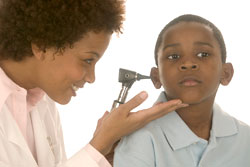
Of adults exposed to rhinovirus or influenza A, 50–80% also experience problems draining their middle ear.
Although the name is confusing, middle ear infections may not involve infection with bacteria. There may just be swelling and pain due to poor drainage, or due to infection with the virus itself. Antibiotics are usually not required, as they have no effect on cold viruses.
Sinusitis
Infection of the sinuses (sinusitis) with bacteria occurs as a complication of colds in 0.5–2% of people. Problems with the sinuses are often due to the virus itself, rather than to a bacterial complication. This usually resolves on its own. Pain in the face or teeth may indicate bacterial infection, which may require antibiotics to treat.
Lower respiratory tract infection
Certain viruses that cause the common cold may spread to the lungs, causing pneumonia. The virus may make the lungs more susceptible to infection with bacteria, resulting in secondary bacterial pneumonia. The elderly and people with lung disease (e.g. COPD) are at increased risk of pneumonia following the common cold.
Exacerbation of asthma
There is a clear association between the common cold and exacerbations of asthma. Common colds (viral infection of the upper respiratory tract) are present in up to 40% of acute asthma attacks in adults. In one study of adults, symptoms of common cold were reported in 80% of episodes of wheezing and breathlessness.
Symptoms of Common Cold
Symptoms of the common cold vary depending on which virus causes the infection, as well as the age and general health of the person who is infected. Symptoms usually occur 24–72 hours after infection.
The first symptom is usually a sore or ‘scratchy’ throat, followed soon after by nasal stuffiness and discharge (runny nose), sneezing and coughing. The throat is usually only sore for a brief time. The cough symptoms are usually worse on the fourth or fifth day of illness, while the nose symptoms improve. The nasal discharge is initially watery, and becomes thicker and yellowish. This does not necessarily indicate a bacterial infection.
The cold syndrome may include other symptoms, including:
- Headache
- Tiredness
- Hoarseness
- Conjunctivitis
- Occasionally muscle aches
Symptoms generally last for seven to ten days.Cough may continue for up to four weeks.
Compared with influenza, colds only rarely result in fever in adults; however, in children, fever is commonly associated with any upper respiratory tract infection. Influenza infection is far more likely to result in high fever, muscle aches and headache than a cold, and less likely to be associated with a runny or stuffy nose.
Clinical Examination of Common Cold

Although the common cold is usually easy to diagnose, the doctor may need to rule out the following conditions:
- Influenza (high fever, headache and muscle aches are often present);
- Sinusitis (facial pain and thick nasal discharge are often present);
- Allergic or seasonal rhinitis (does not usually present with sore throat and cough);
- Bacterial pharyngitis or tonsillitis (runny nose and nasal stuffiness are not usually present); and
- Whooping cough (initially similar the common cold initially, but fits of coughing and sometimes short periods of breath-holding occur, and tend to persist for weeks);
- Diphtheria: if the individual has travelled to a country where they may have been exposed to this disease;
- Meningococcal infection: which produces respiratory symptoms but often also causes neurological signs; or
- HIV sero-conversion: which often produces non-specific symptoms similar to the common cold.
How is Common Cold Diagnosed?
In almost all cases, the cold can be diagnosed without any tests needing to be done. Most adults are able to accurately diagnose themselves. In the early stages, it may be difficult to know whether symptoms of a cold are due to other conditions such as hayfever, glandular fever or strep throat, particularly in children. If persistent nasal discharge is present, especially if it is on one side, foreign bodies in the nose (e.g. crayons or toys) need to be ruled out.
If the doctor is particularly concerned about ruling out other conditions, or finding out which virus has caused the cold, they may take a throat or nose swab, or, less commonly, suck the secretions from the back of the nose with a small tube. This is rarely necessary. The treatment of the cold is the same regardless of which virus has caused it.
Prognosis of Common Cold
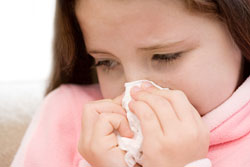
Colds usually last for three to seven days, although 25% of cases last up to two weeks. Postviral cough may continue for four weeks, because the airways are more sensitive.
Following recovery from the common cold, re-exposure to the same or similar virus usually produces reinfection, which is milder and of shorter duration than the initial illness.
People who have weak immune systems, have chronic disease, are malnourished or are smokers may experience complications which may be serious, or even life-threatening. The most significant complication is secondary bacterial infection, most notably pneumonia.
How is Common Cold Treated?
The development of a ‘cure’ for the common cold is not likely any time in the near future, because the cold is caused by so many different viruses that cause illness in different ways. Current treatment for colds is therefore targeted towards control of symptoms.
The following strategies are recommended for treatment of the common cold:
- Adequate sleep and rest;
- Use of paracetamol (e.g. Panadol) for pain control and fever;
- Steam inhalations for a blocked nose. Inhalation of steam is thought to improve nasal congestion by reducing the stickiness of secretions, and possibly due to heat sensitivity of the virus. Studies investigating steam inhalation efficacy have not consistently shown a benefit;
- Cough mixture for a dry cough;
- Drinking enough fluids;
- In adults, gargling aspirin in water or lemon juice for a sore throat. Do not give aspirin to children without first seeking your doctor’s advice, due the the risk of Reye’s syndrome.
- Using moisturising cream around the nose and soft tissues may help prevent sore, dry, red skin around the nose.
A doctor may also provide the following advice:
- Information regarding the usual course and duration of the illness;
- Reassurance that antibiotics are not required or helpful; and
- Advice to return for review if the condition worsens or lingers beyond the expected timeframe.
Medications
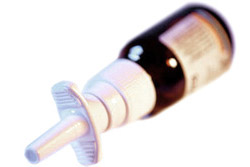
Decongestants taken as a nasal spray or as a tablet may be used to reduce nasal stuffiness.
Certain antihistamines may reduce sneezing and runny nose. Antihistamines alone are not an effective treatment for the common cold.In combination with decongestants, antihistamines may lead to some relief from a blocked or runny nose.
Non-steroidal anti-inflammatory drugs (NSAIDs) such as ibuprofen (e.g. Nurofen) may be used to reduce fever and sore throat associated with the common cold, and may also have a beneficial effect on cough.
Intranasal ipratropium (e.g. Atrovent) may play a role in reducing runny nose.
Cough medications are not particularly useful for the common cold, though they may be appropriate in some instances when cough is persistant.
Intranasal and oral steroids have not shown a clinical benefit in the treatment of the common cold.
Antiviral medications such as zanamivir (Relenza) and oseltamivir (Tamiflu) may be used effectively to treat certain patients with influenza. They are not used to treat the common cold because they are expensive, have side effects, and are likely to have only a small impact on symptoms.
Antibiotics are designed to treat bacterial infections, and as such do not have a role to play in the treatment of the viruses that lead to an uncomplicated common cold. Antibiotics have not been found to shorten the length of the common cold, and they do not reduce the likelihood of secondary bacterial infection.
Supplements
Zinc has been proposed to reduce the severity and duration of colds, but its efficacy has not been proven in good clinical trials.
Echinacea is used widely to shorten the length or decrease the severity of symptoms of the common cold. The preparations of this drug vary greatly, and there is limited evidence of its efficacy for shortening or decreasing severity of symptoms or for preventing colds. Some trials have suggested that certain preparations of Echinacea, such as those based on the species Echinacea purpurea, might be effective in reducing cold symptoms and length in adults. Side effects are infrequent, though rashes have been reported in some children.
The use of vitamin C to treat or prevent the common cold has been popular for some time. One study with 11,350 participants tested doses of at least 0.2 g per day of vitamin C, and found that regularly taking vitamin C did not reduce the likelihood of catching a cold. Some trials found a significant reduction in the risk of common cold in participants exposed to short periods of extreme physical or cold stress (such as marathon running and skiing) with administration of vitamin C. Regularly taking vitamin C slightly reduced the length and severity of common cold symptoms, although the effect is so minimal that the usefulness of this is in doubt. High dose vitamin C started after the onset of cold symptoms showed no consistent effect on severity or length of symptoms. More research is required to clarify the use of this vitamin.
There are no trials of sufficient quality to support the use of Chinese medicinal herbs for the treatment of the common cold. Further research is required.
Prevention
Due to the limited effectiveness of treatment for the common cold, prevention of infection is very important, particularly in vulnerable people. A ‘cold vaccine’ is not available, and is not likely to be developed for some time because the cold is caused by so many different viruses that cause illness in different ways.
Strategies to prevent developing the common cold include:
- Limiting exposure by washing hands regularly, avoiding crowds and sick people, and disinfecting surfaces;
- Practicing healthy habits, such as eating and sleeping well, reducing stress, stopping smoking, and regular moderate exercise; and
- Receiving the flu vaccination will help to prevent cold-like symptoms due to influenza infection.
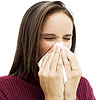 |
For more information, see Tips to Prevent Colds and Flus. |
More information
 |
For more information on the common cold and influenza, types of influenza and treatments and tips for preventing influenza, see Cold and Flu. |
Common Cold References
- Heikkinen T, Järvinen A. The common cold. Lancet. 2003; 361(9351): 51-9.
- Gustafson LM, Proud D, Hendley JO, Hayden FG, Gwaltney JM Jr. Oral prednisone therapy in experimental rhinovirus infections. J Allergy Clin Immunol. 1996; 97(4): 1009-14.
- Turner RB. Epidemiology, pathogenesis, and treatment of the common cold. Ann Allergy Asthma Immunol. 1997; 78(6): 531-9.
- Gwaltney JM Jr, Hendley JO. Transmission of experimental rhinovirus infection by contaminated surfaces. Am J Epidemiol. 1982; 116(5): 828-33.
- Hendley JO, Gwaltney JM Jr. Mechanisms of transmission of rhinovirus infections. Epidemiol Rev. 1988; 10: 243-58.
- Hendley JO, Wenzel RP, Gwaltney JM Jr. Transmission of rhinovirus colds by self-inoculation. N Engl J Med. 1973; 288(26): 1361-4.
- Kirkpatrick GL. The common cold. Prim Care. 1996; 23(4): 657-75.
- Warshauer DM, Dick EC, Mandel AD, Flynn TC, Jerde RS. Rhinovirus infections in an isolated Antarctic station. Transmission of the viruses and susceptibility of the population. Am J Epidemiol. 1989; 129(2): 319-40.
- Aronson MD, Weiss ST, Ben RL, Komaroff AL. Association between cigarette smoking and acuterespiratory tract illness in young adults. JAMA. 1982; 248(2): 181-3.
- Treanor JJ. Influenza virus. In: Mandell GL, Bennett JE, Dolin R (eds). Principles and practice of infectious diseases (5th edition). Philadelphia: Churchill Livingstone; 2000: 1823-49.
- Harris JM 2nd, Gwaltney JM Jr. Incubation periods of experimental rhinovirus infection and illness. Clin Infect Dis. 1996; 23(6): 1287-90.
- Gwaltney JM Jr, Hayden FG. Psychological stress and the common cold. N Engl J Med. 1992; 326(9): 644-5.
- Winther B, Gwaltney JM Jr, Mygind N, Turner RB, Hendley JO. Sites of rhinovirus recovery after point inoculation of the upper airway. JAMA. 1986; 256(13): 1763-7.
- Nicholson KG. Human influenza. In: Nicholson KG, Webster RG, Hay AJ (eds). Textbook of Influenza. Oxford: Blackwell Science; 1998: 219-64.
- Heikkinen T, Ruuskanen O, Ziegler T, Waris M, Puhakka H. Short term use of amoxicillin-clavulanate during upper respiratory tract infection for prevention of acute otitis media. J Pediatr. 1995; 126(2): 313-6.
- Rovers, MM, Schilder, AG, Zielhuis, GA, Rosenfeld, RM. Otitis media. Lancet 2004; 363:465.
- Koivunen P, Kontiokari T, Niemelä M, Pokka T, Uhari M. Time to development of acute otitis media during an upper respiratory tract infection in children. Pediatr Infect Dis J. 1999; 18(3): 303-5.
- McBride TP, Doyle WJ, Hayden FG, Gwaltney JM Jr. Alterations of the eustachian tube, middle ear, and nose in rhinovirus infection. Arch Otolaryngol Head Neck Surg. 1989; 115(9): 1054-9.
- Doyle WJ, Skoner DP, Hayden F, Buchman CA, Seroky JT, Fireman P. Nasal and otologic effects of experimental influenza A virus infection. Ann Otol Rhinol Laryngol. 1994; 103(1): 59-69.
- Heikkinen T, Thint M, Chonmaitree T. Prevalence of various respiratory viruses in the middle ear during acute otitis media. N Engl J Med. 1999; 340(4): 260-4.
- Gwaltney JM Jr. The common cold. In: Mandell GL, Bennett JE, Dolin R (eds). Principles and Practice of Infectious Diseases (5th edition). Philadelphia: Churchill Livingstone; 2000: 651-5.
- Gwaltney JM Jr, Phillips CD, Miller RD, Riker DK. Computed tomographic study of the common cold. N Engl J Med. 1994; 330(1): 25-30.
- Puhakka T, Mäkelä MJ, Alanen A, Kallio T, Korsoff L, Arstila P, et al. Sinusitis in the common cold. J Allergy Clin Immunol. 1998; 102(3): 403-8.
- Juvén T, Mertsola J, Waris M, Leinonen M, Meurman O, Roivainen M, et al. Etiology of community-acquired pneumonia in 254 hospitalized children. Pediatr Infect Dis J. 2000; 19(4): 293-8.
- Seemungal T, Harper-Owen R, Bhowmik A, Moric I, Sanderson G, Message S, et al. Respiratory viruses, symptoms, and inflammatory markers in acute exacerbations and stable chronic obstructive pulmonary disease. Am J Respir Crit Care Med. 2001; 164(9): 1618-23.
- Larson HE, Reed SE, Tyrrell DAJ. Isolation of rhinoviruses and coronaviruses from 38 colds in adults. J Med Virol. 1980; 5(3): 221-9.
- Han LL, Alexander JP, Anderson LJ. Respiratory syncytial virus pneumonia among the elderly: An assessment of disease burden. J Infect Dis. 1999; 179(1): 25-30.
- Wendt CH, Hertz MI. Respiratory syncytial virus infections in the immunocompromised host. Semin Respir Infect. 1995; 10(4): 224-31.
- Ghosh S, Champlin R, Couch R, Englund J, Raad I, Malik S, et al. Rhinovirus infections in myelosuppressed adult blood and marrow transplant recipients. Clin Infect Dis. 1999; 29(3): 528-32.
- Nicholson KG, Kent J, Ireland DC. Respiratory viruses and exacerbations of asthma in adults. BMJ. 1993; 307(6910): 982-6.
- Kistler A, Avila PC, Rouskin S, Wang D, Ward T, Yagi S, et al. Pan-viral screening of respiratory tract infections in adults with and without asthma reveals unexpected human coronavirus and human rhinovirus diversity. J Infect Dis. 2007; 196(6): 817-25.
- Gern JE, Galagan DM, Jarjour NN, Dick EC, Busse WW. Detection of rhinovirus RNA in lower airway cells during experimentally induced infection. Am J Respir Crit Care Med. 1997; 155(3): 1159-61.
- Kelly JT, Busse WW. Host immune responses to rhinovirus: Mechanisms in asthma. J Allergy Clin Immunol. 2008; 122(4): 671-82.
- Folkerts G, Nijkamp FP. Virus-induced airway hyperresponsiveness. Role of inflammatory cells and mediators. Am J Respir Crit Care Med. 1995; 151(5): 1666-73.
- Eccles R. Understanding the symptoms of the common cold and influenza. Lancet Infect Dis. 2005; 5(11): 718-25.
- Tyrrell DA, Cohen S, Schlarb JE. Signs and symptoms in common colds. Epidemiol Infect. 1993; 111(1): 143-56.
- Antibiotic Expert Group. Influenza. In: Therapeutic Guidelines: Antibiotic. Version 13. Melbourne: Therapeutic Guidelines Limited; 2006.
- Peltola V, Waris M, Österback R, Susi P, Hyypiä T, Ruuskanen O. Clinical effects of rhinovirus infections. J Clin Virol. 2008; 43(4): 411-4.
- Arruda E, Pitkäranta A, Witek TJ Jr, Doyle CA, Hayden FG. Frequency and natural history of rhinovirus infections in adults during autumn. J Clin Microbiol. 1997; 35(11): 2864-8.
- Nicholson KG, Kent J, Hammersley V, Cancio E. Acute viral infections of upper respiratory tract in elderly people living in the community: Comparative, prospective, population based study of disease burden. BMJ. 1997; 315(7115): 1060-4.
- Carrat F, Tachet A, Rouzioux C, Housset B, Valleron AJ. Evaluation of clinical case definitions of influenza: Detailed investigation of patients during the 1995-1996 epidemic in France. Clin Infect Dis. 1999; 28(2): 283-90.
- Monto AS, Gravenstein S, Elliott M, Colopy M, Schweinle J. Clinical signs and symptoms predicting influenza infection. Arch Intern Med. 2000; 160(21): 3243-7.
- Kim HW, Wyatt RG, Fernie BF, Brandt CD, Arrobio JO, Jeffries BH, et al. Respiratory syncytial virus detection by immunofluorescence in nasal secretions with monoclonal antibodies against selected surface and internal proteins. J Clin Microbiol. 1983; 18(6): 1399-404.
- Nikkari S, Halonen P, Kharitonenkov I, Kivivirta M, Khristova M, Waris M, et al. One-incubation time resolved fluoroimmunoassay based on monoclonal antibodies in detection of influenza A and B viruses directly in clinical specimens. J Virol Methods. 1989; 23(1): 29-40.
- Cox NJ, Subbarao K. Influenza. Lancet. 1999; 354(9186): 1277-82.
- Krilov LR, Lipson SM, Barone SR, Kaplan MH, Ciamician Z, Harkness SH. Evaluation of a rapid diagnostic test for respiratory syncytial virus (RSV): Potential for bedside diagnosis. Pediatrics. 1994; 93(6 Pt 1): 903-6.
- Fan J, Henrickson KJ, Savatski LL. Rapid simultaneous diagnosis of infections with respiratory syncytial viruses A and B, influenza viruses A and B, and human parainfluenza virus types 1, 2, and 3 by multiplex quantitative reverse transcription-polymerase chain reaction enzyme hybridization assay (Hexaplex). Clin Infect Dis. 1998; 26(6): 1397-402.
- McIntosh K, Halonen P, Ruuskanen O. Report of a workshop on respiratory viral infections: Epidemiology, diagnosis, treatment, and prevention. Clin Infect Dis. 1993; 16(1): 151-64.
- Heikkinen T, Salmi AA, Ruuskanen O. Comparative study of nasopharyngeal aspirate and nasal swab specimens for detection of influenza. BMJ. 2001; 322(7279): 138.
- Pratter M. Cough and the common cold: ACCP evidence-based clinical practice guidelines. Chest. 2006; 129(1 Suppl): 72-4S.
- Arroll B. Common cold. Clin Evid. 2006; (15): 2006-14.
- Sutter AI, Lemiengre M, Campbell H, Mackinnon HF. Antihistamines for the common cold. Cochrane Database Syst Rev. 2003; (3): CD001267.
- Tan T, Little P, Stokes T. Antibiotic prescribing for self limiting respiratory tract infections in primary care: Summary of NICE guidance. BMJ. 2008; 337: a437.
- Eccles R. Efficacy and safety of over-the-counter analgesics in the treatment of common cold and flu. J Clin Pharm Ther. 2006; 31(4): 309-19.
- Sperber SJ, Sorrentino JV, Riker DK, Hayden FG. Evaluation of an alpha agonist alone and in combination with a nonsteroidal antiinflammatory agent in the treatment of experimental rhinovirus colds. Bull NY Acad Med. 1989; 65(1): 145-60.
- Gwaltney JM Jr, Druce HM. Efficacy of brompheniramine maleate for the treatment of rhinovirus colds. Clin Infect Dis. 1997; 25(5): 1188-94.
- Sperber SJ, Hendley JO, Hayden FG, Riker DK, Sorrentino JV, Gwaltney JM Jr. Effects of naproxen on experimental rhinovirus colds: A randomized, double-blind, controlled trial. Ann Intern Med. 1992; 117(1): 37-41.
- Hayden FG, Diamond L, Wood PB, Korts DC, Wecker MT. Effectiveness and safety of intranasal ipratropium bromide in common colds: A randomized, double-blind, placebo-controlled trial. Ann Intern Med. 1996; 125(2): 89-97.
- Schroeder K, Fahey T. Over-the-counter medications for acute cough in children and adults in ambulatory settings. Cochrane Database Syst Rev. 2001; (3):. CD001831.
- Meadows M. Beat the winter bugs: How to hold your own against colds and flu. FDA Consumer. 2001; 35(6):11-18. Citation
- Ruohola A, Heikkinen T, Waris M, Puhakka T, Ruuskanen O. Intranasal fluticasone propionate does not prevent acute otitis media during viral upper respiratory infection in children. J Allergy Clin Immunol. 2000; 106(3): 467-71.
- Gubareva LV, Kaiser L, Hayden FG. Influenza virus neuraminidase inhibitors. Lancet. 2000; 355(9206): 827-35.
- Hayden FG, Coats T, Kim K, Hassman HA, Blatter MM, Zhang B, et al. Oral pleconaril treatment of picornavirus-associated viral respiratory illness in adults: Efficacy and tolerability in phase II clinical trials. Antivir Ther. 2002; 7(1): 53-65.
- Linde K, Barrett B, Bauer R, Melchart D, Wölkart K. Echinacea for preventing and treating the common cold. Cochrane Database Syst Rev. 2006; (1): CD000530.
- Marshall I. Zinc for the common cold. Cochrane Database Syst Rev. 2000; (2): CD001364.
- Douglas RM. Hemilä H, Chalker E, Treacy B, Vitamin C for preventing and treating the common cold. Cochrane Database Syst Rev. 2007; (3): CD000980. Abstract
- Wu T, Zhang J, Yan Q, Xie L, Liu G. Chinese medicinal herbs for the common cold. Cochrane Database Syst Rev. 2007; (1): CD004782.
All content and media on the HealthEngine Blog is created and published online for informational purposes only. It is not intended to be a substitute for professional medical advice and should not be relied on as health or personal advice. Always seek the guidance of your doctor or other qualified health professional with any questions you may have regarding your health or a medical condition. Never disregard the advice of a medical professional, or delay in seeking it because of something you have read on this Website. If you think you may have a medical emergency, call your doctor, go to the nearest hospital emergency department, or call the emergency services immediately.







